This is the post I referenced below, the one that was supposed to be finished yesterday. Nevertheless, it’s here now.
One of the most emailed questions I get about this blog is “Who is the artist featured in your banner and side bar?” You know, I’ve had this new blog for over, uhm, two years now, but I’ve never written about the man who is basically the star of it.
Shame on me. Really.
Today (uh, yesterday) seems (seemed) like the perfect day to finally remedy this appalling situation, because today, (again, that would be yesterday) in 1825, the artist himself was born. One of my favorites, obviously.
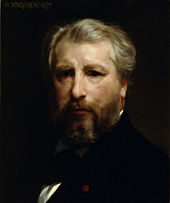
So Happy (now-belated) Birthday, William Bouguereau!
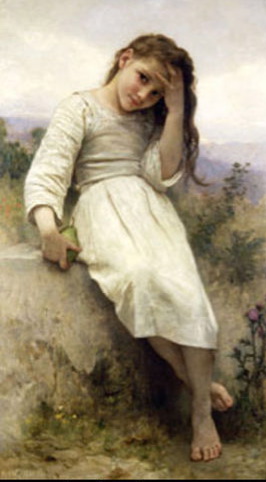
(Here’s my girl, my beloved banner girl, Petite Maraudeuse/Little Thief. Now you can see her in her entirety and see the context for that look in her eye. She’s an angelic little scofflaw. I love her. I love all my Bouguereau girls.)
William Bouguereau, a French artist schooled in the classical, Academic style, was hugely successful for most of his lifetime, lauded within the classical community and by rich patrons of the arts. His themes were alternately religious and pagan; fantastical and earthy. He loved painting nymphs and goddesses and bathers and children, creating a light-infused dreamworld so soft and clear and precise that it seemed it must surely be real.
Fred Ross, Chairman of The Art Renewal Center, says of Bouguereau:
Bouguereau ….. was especially sensitive to the difficulties in growing up. In his depictions of childhood, he manages to capture the most exquisite subtle nuances of insecurity, self-consciousness, the search for identity, the struggle with budding sensuality and the conflict between the need to mature and the joy of wanting to stay immersed in childhood.
With an imagery at once extraordinary, fanciful, and sublime, he often conjured an ethereal universe of transcendent beauty – an idyllic and shimmering realm from which ugliness, poverty and pessimism were forever banned. These works he balanced by those reminding the more fortunate in society to care for the young, the poor and the suffering.
But even as Bouguereau’s career and reputation burgeoned, as he became a celebrity, basically, art philosophies began colliding. Impressionism was gaining popularity. Degas, Monet, Renoir, and others exploded onto the scene. The art world of 19th century France was becoming polarized: Academic vs avant-garde; classical vs Impressionism. He was soundly criticized by the up-and-comers for, basically, not getting with the program. He was “artificial” or just a “technician” or not “progressive.” Degas and other artists mocked his style, but Bouguereau just did what he did. He wasn’t swayed by all the newness swirling around him. The storm of rebellion against traditional values in painting raged around him but he just continued painting his dream world of virgins and myths and childhood — his own idea of beauty. As much as I love the work of the Impressionists, I have to applaud Bouguereau for this, for sticking to his own principles, for not allowing himself to be swept away in the churning tide of change. I mean, why should he? Why surrender everything he’d learned, everything he was, everything he’d become, to what a select group of, well, somewhat rabid artists and elites thought he should be or should become? Good for you, Bouguereau. That’s part of why I love you. He was true to everything that made him him. He wasn’t Monet or Degas or Pissarro and he wasn’t going to try to be. Whatever artistic furor blew outside his window, Bouguereau basically could not give one tiny rat’s bottom, although he probably wouldn’t have said it that way. (Because, obviously, he would have said I do not give one tiny rat’s bottom in French.) Still, his resolute self-awareness and perseverance make me want to stand up and cheer. He knew what he was and what he was not.
As if attacks on his work weren’t enough, his critics slandered him personally and relentlessly. He’s stingy, they’d say, despite the fact that he frequently organized sales to benefit his struggling colleagues. He’s a lecher, they’d say, despite no concrete evidence whatsoever. He only wants to paints nudes, they’d say, despite the fact that nudes comprised only about ten percent of Bouguereau’s body of work. (Even so, it is shocking. I mean, we all know that NO artist before him had EVER painted nudes.)
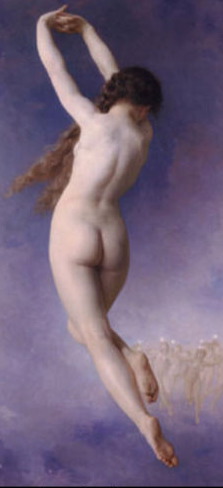
L’etoile Perdue/The Lost Pleiad (Gorgeous. I must be a lech.)
Bouguereau, though, didn’t waste time defending himself or giving any attention to the lies, the rumors, the insanity of it all. He just quietly did what he did. Part of me wants to scream, “Defend yourself, man! They’re all LIES!” but how much creative energy, better spent on his work, would he have frittered away on that? Instead, he took the higher ground. Kept at his work. Let the work speak for itself and for him. You know, it’s mind-boggling to me, the sheer almost tyrannical force that flew at him from certain factions simply because he wasn’t seen as “progressive.”
Here’s what Damion Bartoli, a biographer of Bouguereau’s, says of the effect of the growing Impressionist influence on Bouguereau and other Academic painters of the time:
Little by little, despite their popularity with the public, the most celebrated painters of the Academy – Bouguereau, Gérôme, Cabanel, Meissonier, Bonnat, Lefèbvre – found themselves blacklisted by a group of youthful artists supported by a cooperative press and the fabulous inherited wealth of a few “high priest†patrons of this avant garde who were on the brink of monopolizing the official posts — in the Beaux-Arts, in the teaching profession, and in the curatorial positions of the major museums.
Still, Bouguereau was undaunted. The new fashion simply didn’t suit him. His dedication to his own vision could not be altered or swayed. A master colorist and draftsman, he pursued the perfection of his dream world his entire working life.
Bartoli says of Bouguereau’s habits:
Rising at six o’clock, he would install himself in his studio and stay there without budging until nightfall, appeasing his midday hunger with eggs and his thirst with a glass of water. He received guests, he smoked, he chatted, he joked; but he did not stop – he never stopped. As soon as the light became insufficient for painting, he worked at his voluminous correspondence, then finally; letting his imagination wander, he would search for new subjects, designing new compositions by lamplight, stopping only when weariness got the best of him.
Bouguereau was also a generous teacher. Another reason I love him. He was passionate about sharing his knowledge, championing the work of the Old Masters — Raphael was a favorite — to his students his entire life, while at the same time allowing his students free expression of their own vision and individuality. He taught as he had been taught: technique and freedom. The one was born from the other. I love that mindset — a perfect combination in a teacher, if you ask me. He extolled the virtues of studying the craft of painting and practiced what he preached. In addition, Bouguereau was a trailblazer, advocating for the integration of women into the ateliers and academies. He personally taught women in his own atelier and, later, largely through Bouguereau’s own influence and example, women were allowed into the prestigious Julian Academy and the Ecole des Beaux-Arts. Late in life, after many years of being a widower, Bouguereau married one of his students, American Elizabeth Jane Gardner, who became an accomplished artist in her own right.
Some students, though, were far less amenable, shall we say. Truly difficult, according to Ross:
The most famous of these was Matisse, who quickly dropped out of Bouguereau’s studio. From the start, the master tried to encourage Matisse, but soon threw up his hands in exasperation, noting the young man’s weaknesses, “You badly need to learn perspective,†he said to him, “But first, you need to know how to hold a pencil. You will never know how to draw.â€
(Clearly, Matisse found his way somehow. But hahahaha. Bouguereau obviously thought he was a slackass.)
His personal life was filled with tragedy. By the end of his life, Bouguereau had outlived his first wife and four of his five children. How he kept creating under the weight of so much sorrow, how he didn’t just shut down, become paralyzed with too much grief, I cannot even fathom, although perhaps a clue can be found in his own quote:
Each day I go to my studio full of joy; in the evening when obliged to stop because of darkness I can scarcely wait for the next morning to come…if I cannot give myself to my dear painting I am miserable.
I love that. He was his art.
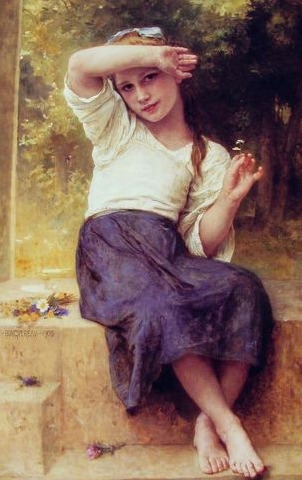
Bouguereau died in 1905, his reputation obscured — along with those of other Academic artists — under a cloud of lingering hostility. Impressionism had basically reinvented art; it represented progress, a fresh newborn approach. A traditional artist like Bouguereau, however, had become — even posthumously — a blaring example of “what not to do”; his work was “old establishment,” a rigid dying aesthetic. This was the general opinion towards most of the great artists of the Academie, but Bouguereau seemed to get an extra bite of venom from his detractors. A prolonged catty backlash. I mean, pick up any art history book published from 1910 to 1980 and Bouguereau, if mentioned at all, will be presented as a bad example or perhaps as Matisse’s (really frustrated) teacher. The man who in his day was considered the most important French artist of the 19th century and one of the greatest painters of the human form was basically expunged from art history for nearly two generations. (A similar thing happened to Rembrandt, but that’s another story.)
Now, this is just my opinion, but I think that extra venom has to do with his being a teacher. He didn’t just practice the “old ways,” he preached them to others. Perpetuated them. He was basically a conservator of the methods of the Old Masters he so dearly loved. But practicing the traditional methods in his own work might have been one thing; evangelizing about them quite another. Perhaps mentoring another generation in those “old establishment” ways embittered his critics even more. You’re rigid, Bouguereau, but keep it to yourself. Don’t spread your disease. Of course, this whole thing is just a theory of mine, but it might explain some of the extra measure of rancor Bouguereau has received over the years. What he did, he taught others to do, and perhaps that carried with it a more severe punishment from those who considered themselves more modern and forward-thinking. Again, a theory.
As the 20th century marched on, Bouguereau’s works were lost to basements and attics and dusty storage rooms. People lucky enough to possess one of his gorgeous ethereal paintings didn’t even know what they had. Before the 1960s, it wasn’t uncommon for his pieces to sell for as little as $500. That’s how invisible, how forgotten, he’d become. Uhm, Bouguereau who?? By 1980, though, Bouguereau was experiencing some artistic redemption. The art world was finally giving him a long-deserved second look and his pieces began selling for millions at auction. That being said, he still remains a polarizing figure in art circles, criticized variously for being “unemotional” and “too emotional.” “Full of flaws” and “too perfect.” “An individualist” and “a pushover.” “Weird” and “conventional.” Good Lord. Make up your minds, people. What’s next? “Too tall” and “Too short”? (He was short, actually.) The pendulum swings wildly to this day with Bouguereau. Depending on your view, he’s either the defender of Western civilization or the enemy of progress. Good guy or bad guy. Hero or devil.
I myself can’t quite understand it, really, or it exhausts me or something, because I like to consider the work. I just want to fall into the work of an artist. Relish it. Soak it up. I don’t feel the need to label him a cultural touchstone or a cultural killjoy. Maybe I’m simplistic, simple-minded, whatever. I just love his work and his dedication to it. That’s what gets my blood going. But for whatever reason, for many many other people, Bouguereau stands at the intersection of the age-old debate between tradition and progress. The debate about him is always about more than the merits of his work. (And there have been debates, actual debates, about this man. Getty Museum 2006.) So I understand that all these complications have always swirled around him, I do, I just prefer not to immerse myself in them when I’m looking at his work. Actually, now that I think of it, he preferred that, too. It was about the work, always the work. I’m just gratified to see that after being forsaken for decades, locked in the basement of public opinion, Bouguereau is slowly — for a growing circle of people — being restored to what I believe he was all along: a genius of light and tone and clarity, a master of ethereal fancies and sun-drenched dreams, a man who never strayed from his personal journey toward absolute beauty, the world outside be damned.
So thank you, William Bouguereau. You give me joy.
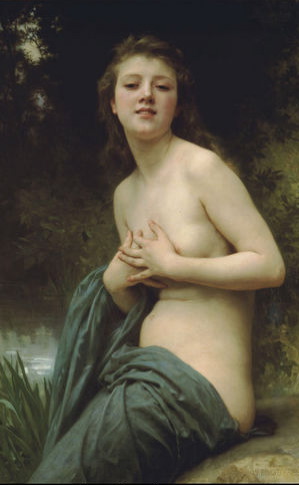
La Brise du Printemps/Spring Breeze
Please go here to enter The Art Renewal Center’s extensive and stunning Bouguereau gallery. I have that whole site bookmarked. So many gorgeous galleries featuring other Masters of classical realism. On the main page, click on “Museum” and enter your search. Again, this site is devoted to classical realism. You won’t find Picasso, but you’ll find enough beauty to keep you occupied and drooling for hours.

Wow. Thank you. That was an AWESOME post. I knew little about Bouguereau before, now I know more.
And I agree with you on this: “Now, this is just my opinion, but I think that extra venom has to do with his being a teacher. He didn’t just practice the “old ways,†he preached them to others. ”
Sadly, I STILL see this in academia. People who do things “the old way” – who haven’t succumbed to the more-flashier-faster mantra are eyed suspiciously. People who “still” lecture instead of doing “open discussion” all the time are sometimes reviled (despite the fact that several good and highly motivated students I have had have told me “Open discussions are often worthless; they devolve into people gossiping or talking about sports instead of the topic”)
I guess what I’m saying is it seems to be a common human trait to celebrate the new and cast aside the old, regardless of whether the new is really ‘all that’ and the old is really outmoded. Obviously Bouguereau’s work is far from outmoded – there is room in the world for the abstract, the impressionist, and the classical.
Along the lines of “I don’t know if it’s art, but I know what I like” – Monet and Matisse and company are obviously also among the greats… but it’s easier to fake the more modern and post-modern art. It takes some obvious skill to paint like Bouguereau, or Rembrandt, or Rockwell – if you have no sense of draftsmanship, your people may be compelling but they won’t be realistic. I could pass off my scratch pad among certain post-modernists despite my complete lack of drawing ability, but if I tried to paint La Petite Maraudeuse (what a fantastic word, by the way!) it would be a dreadful mess.
Someday good-looking work will be avante-garde again, and then what? I love that he stuck to his brushes. Thanks for a great post, Tracey!
Beautiful work and loved to learn more about him! I think a lot of artists who end up being “timeless” face a lot of hostility in their own age. You can see that with writing, films (you know – Bringing Up Baby was a flop, and all that), and also painting. Trends are good, change is good – I mean, if you want to look at a dead art that is fearful of any kind of change go to see most opera (in America, I mean – notin Europe, where they have kept it alive, and fresh, and open to change). If you try to keep the art form the same, and are hostile to changing it up – then all you will have is a beautiful surface with no substance.
I love his luscious colors and I also love his faces!! I love Renoir’s stuff – but his faces all look the same. His paintings obviously aren’t about the faces, it’s more about the colors and the light – but I love Bougeuereau’s beautiful faces! His idealism and love really shines through.
I love the nude one (I am also a lech, apparently). It reminds me a little bit of Maxfield Parrish’s stuff, except without the acid flashback je ne sais quoi.
You know, it’s interesting. That site that I mentioned, Art Renewal Center, has an amazing selection of galleries. Truly breathtaking. I recommend anyone click on it and spend some time over there getting to know some new artists or visiting some old favorites.
That being said, I’m opposed to their overall philosophy. They are staunchly vehemently anti-Modernist. They are HUGE champions of Bouguereau’s work and generally all pissed off on his behalf that he was the recipient of all this “anti-traditionalist” ire. To me, though, what was done to Bouguereau, that site is now doing to Modernism. Such vehement opposition. They’re basically guilty of the same thing — from the opposite side. I don’t get it. Why not just promote a love of and a renaissance of classical styles, etc.? Why accompany that promotion with such rabid opposition of other styles? That’s not my bag. Celebrate artists like Bouguereau and John William Waterhouse, by all means, I’m all for it, but don’t slam other styles in the process. It makes you look small. I don’t feel the need to blast the modern in order to love the traditional. I love them both. It’s petty.
But, again, I LOVE that site and go there all the time. I just would never buy anything from their store or donate to their cause.
I will simply indulge in their gorgeous freebie galleries in a leech-like way.
Oh, and the nude? Yeaah. If there is a more beautiful and creamy bottom rendered in the history of art, I have yet to see it. She isn’t even real and I am struggling with jealousy of her.
On the other hand, I could see myself sacrificing one of my face girls just to put that butt on my side bar.
Please find a towel, Lost Pleiad. You shame us all.
I could see myself sacrificing one of my face girls just to put that butt on my side bar.
hahahahahahahahaha
Yeah, I totally see what you’re saying about the gallery (it is gorgeous) and their philosophy (pitting styles against one another). I have never really gotten the either/or thing either – we’ve talked about that before in terms of acting styles. You know, the Method acting snots – or the classically trained snots – who all seem to believe that there is only ONE way to get there, and it is THEIR way. There are the snotty modern-day actors who think that Spencer Tracy – SPENCER TRACY – is somehow LESS than modern actors because he … what … didn’t use sense memory? So strange – I have never felt that way.
There’s an insecurity there, I think. LIke these people need to believe that their way can be the only REAL way … because if it is revealed that OTHER people “get there” too and didn’t choose THEIR way … then … what would that mean for them??
I think the development of art is fascinating – one of the best classes I took in college was a huge survey course called Art History 101 or something like that, hundreds of people in the class … but it was awesome, seeing the progression of styles, one thing leading to the other. Fascinating!
Tracey – I think Waterhouse did one of the Ophelias I posted in that post a while back? I think he did the most famous one, of her lying in her back in the water. Let me check.
Uhm, it appears that Waterhouse did nothing BUT paint Ophelia.
/Uhm, it appears that Waterhouse did nothing BUT paint Ophelia./
Yes, I think that’s true! Hahahahaha!
And yes, everybody in the arts lining up in your rigid “either/or” camps:
Please DO stop being SNOTS.
You wear me to a nub. Seriously.
I remember my Art History/Survey/Look-at-slides-in-a darkened-theater class, too. A crush of people around you, breathing heavy because they’ve fallen asleep, the air all hot with their open-mouthed breath. I LOVED that class! I actually stayed awake.
The whole thing – the either/or thing — feels to me like you’re at this sumptuous buffet, salivating over all the choices open to you and then your gramma comes along and tells you that you can only pick one and put it on your plate.
Like wha, gammie??? I want to taste them all, please!
Yeah, really. Please don’t make me choose, gamma!
THANK YOU! I’ve wondered for so long, and I’ve been 100% sure that the girl between “contact” and “meta” is you.
Beautiful post. Not enough whimsy, though. 😉
sarahk — I need to post the full image of the “contact/meta” girl.
And yes, not enough whimsy, you’re right. HA! We are still not over it.
Hi,
I’m a die-hard fan of William Bouguereau and his works of art. I admire him more than Leondardo da Vinci, and his works are really gripping. The sheer beauty and elegance he presents in his works are mind-boggling.
Thanks for this beautiful blog, surrounded by Bouguereau’s works of art. This blog itself is now quite admirable!
-Janice
William Bouguereau is one of my favorite artists. I first learned of him about 20 years ago when I came upon a huge canvas of his at the Cleveland Museum of Art. The piece is titled Le Repos. When I saw it I stopped dead in my tracks and stood in front of it for quite awhile taking in all of the detail and realism of the mother and children portrait. The painting actually brought tears to my eyes.